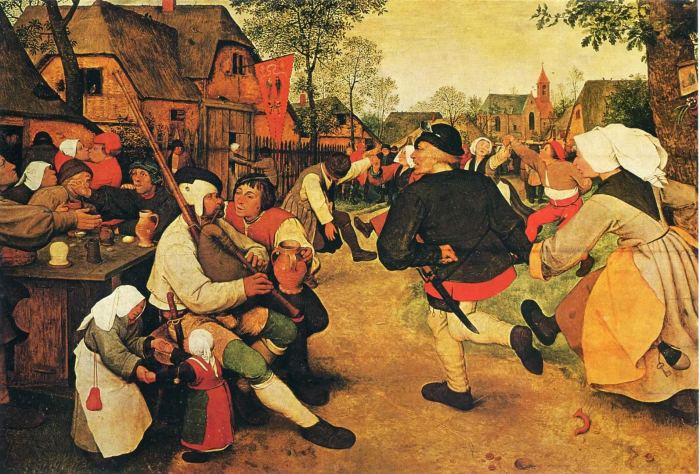Look at pieter bruegel the elder’s peasant dance – Pieter Bruegel the Elder’s Peasant Dance is a captivating and iconic work that encapsulates the essence of Flemish art. This masterpiece offers a rich tapestry of cultural and social commentary, inviting viewers to delve into the lives and traditions of 16th-century peasants.
Bruegel’s meticulous attention to detail and masterful use of color and composition create a vivid and dynamic scene that transports viewers to the heart of a bustling village celebration. The painting’s symbolism and allegorical elements add layers of depth and intrigue, revealing the complexities of peasant life and the social norms of the time.
Introduction: Look At Pieter Bruegel The Elder’s Peasant Dance

Pieter Bruegel the Elder, a renowned Flemish artist of the 16th century, is celebrated for his captivating depictions of peasant life and landscapes. His painting “Peasant Dance,” created around 1567, is a testament to his keen observation of human behavior and his mastery of artistic techniques.
The painting offers a glimpse into the social and cultural norms of Bruegel’s time, providing valuable insights into the lives of the peasantry during the Renaissance period.
Composition and Techniques

“Peasant Dance” is characterized by its dynamic composition, with a circular arrangement of dancing figures occupying the center of the canvas. Bruegel’s use of perspective draws the viewer’s eye into the scene, creating a sense of depth and immersion. The painting’s vibrant colors and skillful handling of light enhance the overall energy and movement, capturing the lively atmosphere of a peasant celebration.
Symbolism and Allegory, Look at pieter bruegel the elder’s peasant dance
The painting is replete with symbolic elements that convey deeper meanings. The circular dance formation represents the cyclical nature of life, while the inclusion of a bagpipe player and a jester alludes to the themes of music and entertainment. The presence of a child urinating in the foreground is often interpreted as a symbol of fertility and renewal.
These elements collectively contribute to the painting’s allegorical significance, inviting viewers to contemplate the broader themes of human existence.
Cultural and Social Commentary
“Peasant Dance” provides a glimpse into the social and cultural norms of Bruegel’s time. The painting depicts a festive gathering of peasants, engaged in a traditional dance. Bruegel’s portrayal of their simple attire, rustic surroundings, and uninhibited revelry reflects the realities of peasant life during the Renaissance period.
The painting also hints at the social hierarchy of the time, with the wealthier figures observing the dance from a distance.
Artistic Legacy and Influence

“Peasant Dance” has had a profound influence on subsequent artists and artistic movements. Its realistic depiction of everyday life and its masterful use of composition and techniques have inspired generations of painters. The painting’s popularity has endured over the centuries, solidifying its status as a masterpiece of Flemish art.
Its influence can be seen in the works of later artists, including Vincent van Gogh and Pablo Picasso.
Query Resolution
What is the significance of the central figure in Peasant Dance?
The central figure, a man playing the bagpipes, represents the joyous spirit of the celebration and serves as a focal point for the composition.
How does Bruegel use color and light to create a sense of atmosphere in the painting?
Bruegel employs vibrant colors and contrasting light and shadow to convey the lively and festive atmosphere of the dance, enhancing the sense of movement and energy.
What are the main allegorical elements present in Peasant Dance?
The painting includes allegorical elements such as the owl, symbolizing wisdom, and the jug, representing fertility and abundance, which add layers of meaning to the scene.